Chess Notes
Edward Winter
When contacting us by e-mail, correspondents are asked to include their name and full postal address and, when providing information, to quote exact book and magazine sources. The word ‘chess’ needs to appear in the subject-line or in the message itself.
| First column | << previous | Archives [173] | next >> | Current column |
11123. Openings monotony
James Mortimer’s comments about the 1908 Lasker v Tarrasch match on page 8 of the Daily Mail, 15 September 1908 (C.N. 11094) included the following:
‘The monotonous repetition of the Ruy López opening, varied only by the equally tiresome and uninteresting French Defence, exhibits a want of enterprise disappointing to those who regard chess as a game par excellence of resource, imagination and self-reliance.’
Among other world championship matches criticized for the ‘monotony’ of the openings played are not only Lasker v Capablanca (1921) and Capablanca v Alekhine (1927) but also Alekhine v Bogoljubow (1929). Page 79 of the January 1930 Chess Amateur quoted from the Yorkshire Observer Budget (date not specified) these comments on the 1929 match:
‘With the exception of about four games the play was confined to some form of the Queen’s Pawn Opening , and this weary persistence may be attributed to the “hypermodern” policy which is a marked feature of the efforts of present-day master players when contesting against each other. Also to the fact that, of all the openings on the chess board, pawn to queen’s fourth in its various phases calls for more close analysis and sound judgement than any other debut.
If those who provide stakes and expenses for championship matches are satisfied with games practically starting with pawn to queen’s fourth, we suppose that the next contest for the championship of the world will most probably be a repetition of monotony of openings, as in the struggle just closed; but the time will come, we think, when combatants in matches and tournaments will be called upon to adopt a more varied policy in regard to the openings.’
In the Internet age, the opening choices of the world’s best players are frequently attacked in real time by nameless ten-opinions-an-hour individuals for whom suitable advice would be: kibitz inwardly.
11124. Charosh v L. Jaffe (C.N.s 3619 & 8023)
C.N.s 3619 and 8023 asked for more information about the game Mannis Charosh v L. Jaffe, New York, 1936 on page 10 of Irving Chernev’s 1000 Best Short Games of Chess (New York, 1955): 1 d4 c5 2 d5 Na6 3 Nf3 d6 4 e4 Bg4 5 Ne5 Qa5+ 6 Bd2 dxe5 7 Bxa5 Bxd1 8 Bb5 mate.
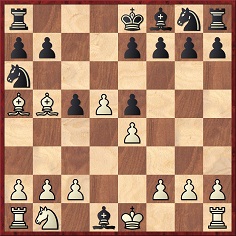
Moshe Rubin (Jerusalem) has taken up the matter with the late Mannis Charosh’s son Paul, who states that Black was ‘Louis Jaffe, a history teacher at New Utrecht High School (Brooklyn) and a colleague of my father’.
Paul Charosh has provided this photograph of his father in play against Irving Chernev in 1942:
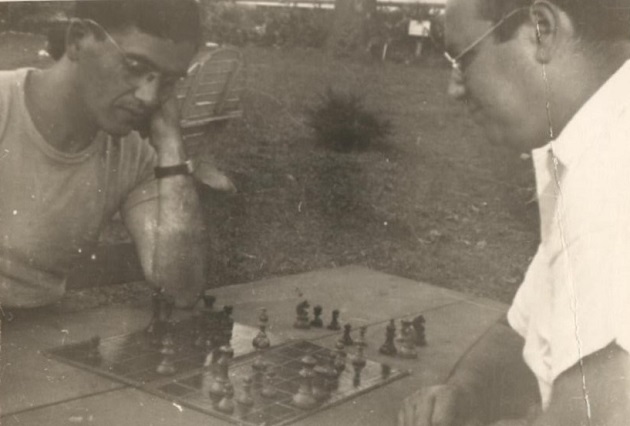
We are also grateful for a shot of Mannis Charosh taken in 1944:
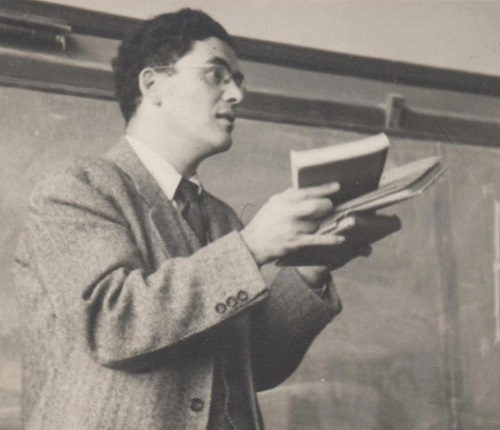
11125. The 1930 Spanish championship
From page 38 of El Ajedrez Americano, March 1931:
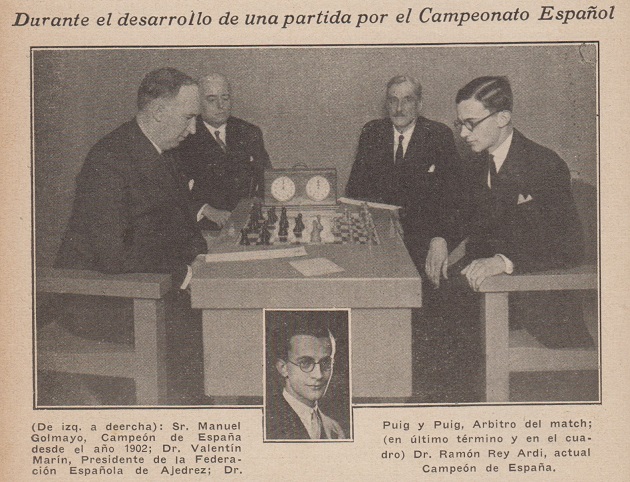
The match between Manuel Golmayo and Ramón Rey Ardid for the Spanish championship was held in Barcelona in December 1930. Rey Ardid won +4 –1 =2 and annotated all the games on pages 39-65 of his book Cien partidas de ajedrez (Saragossa, 1934).
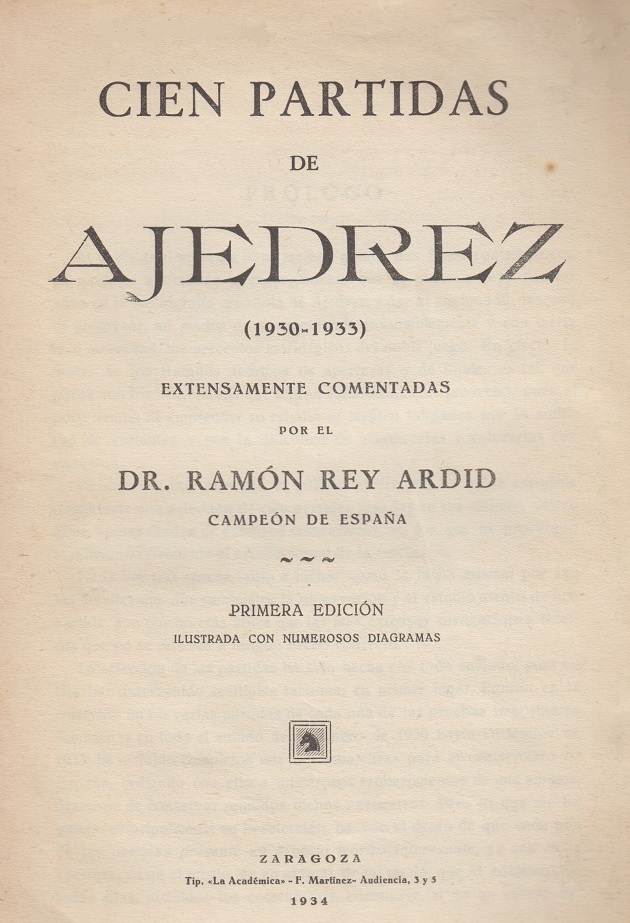
As an example of Rey Ardid’s detailed analysis, below is the sixth match-game:
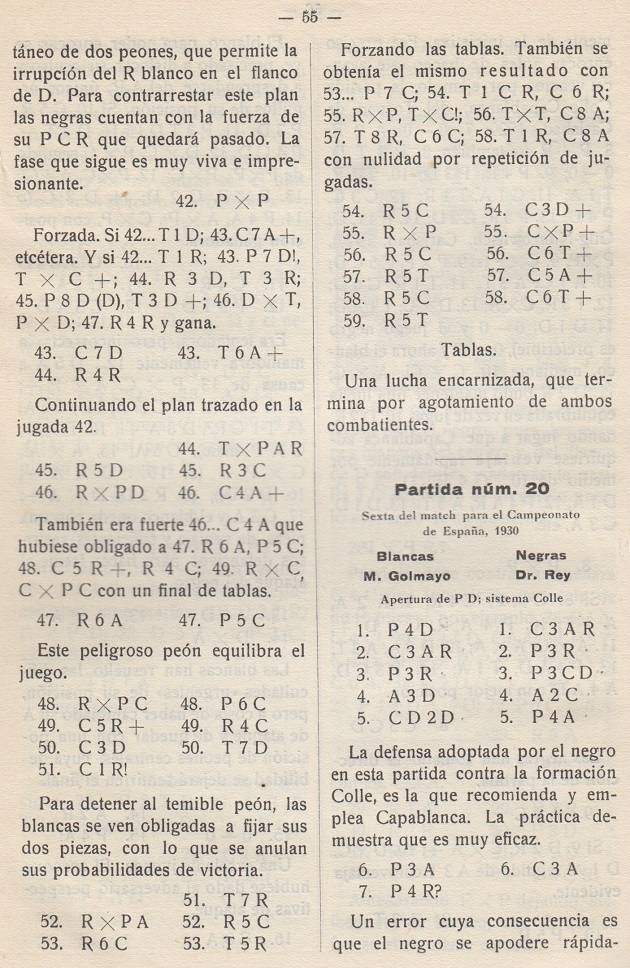
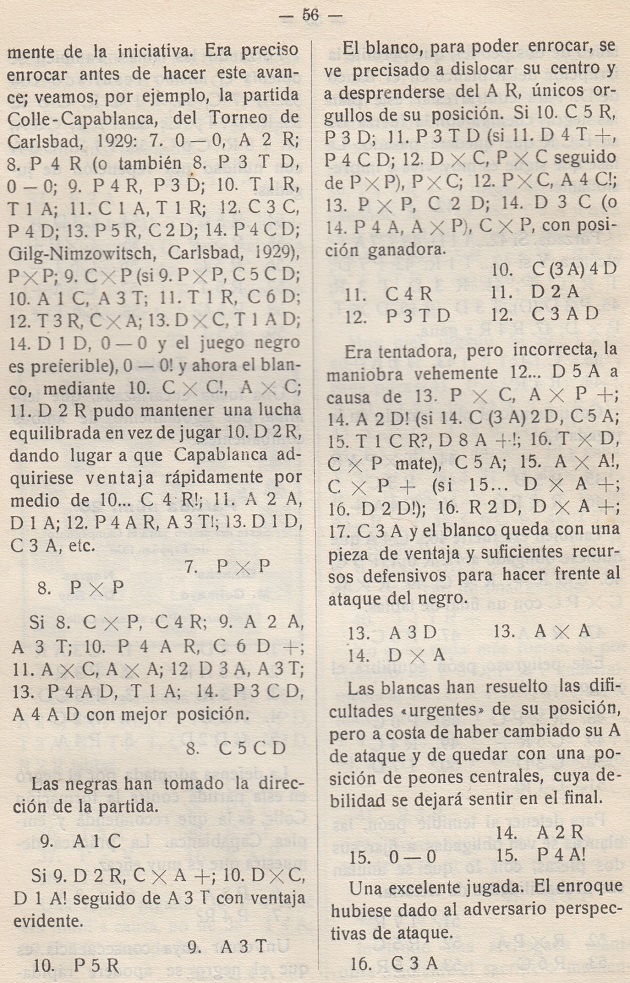
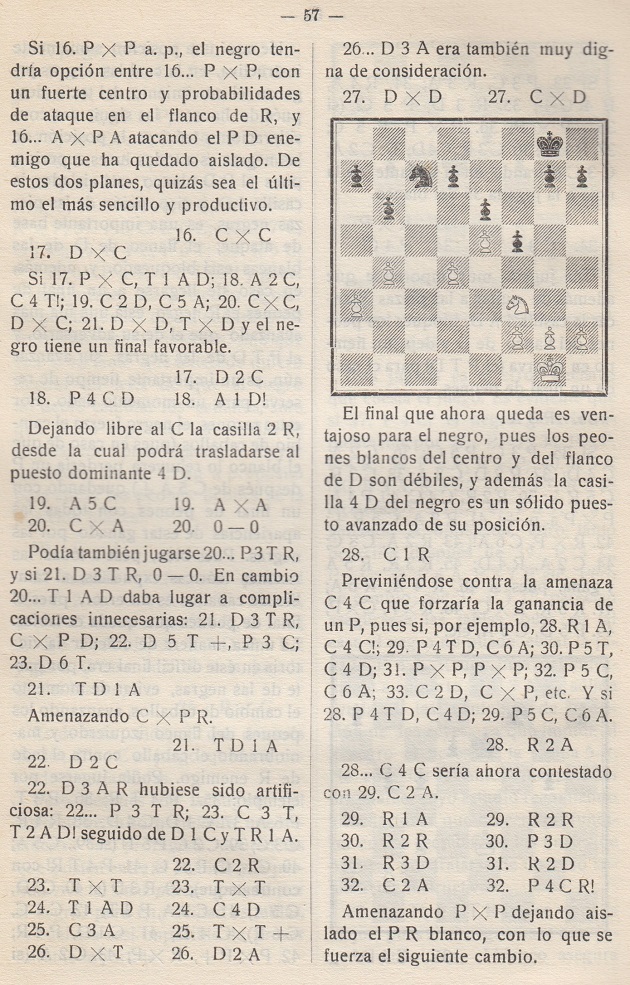
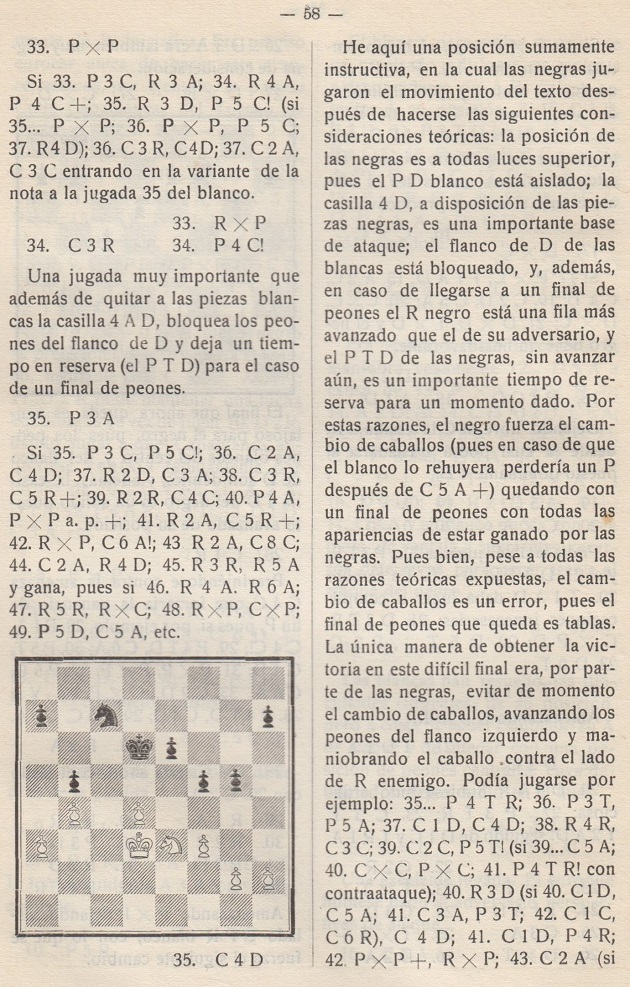
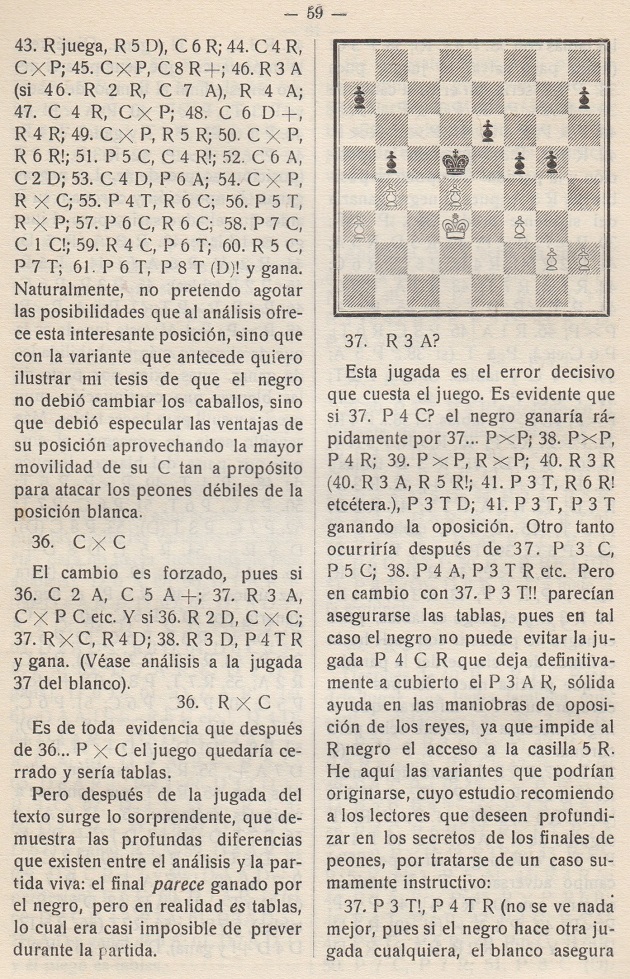
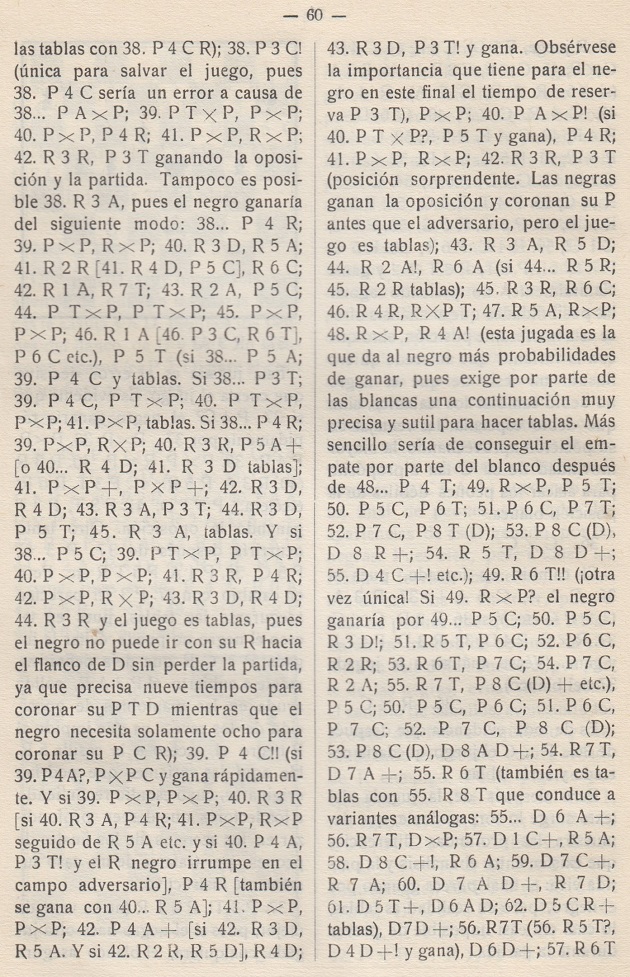

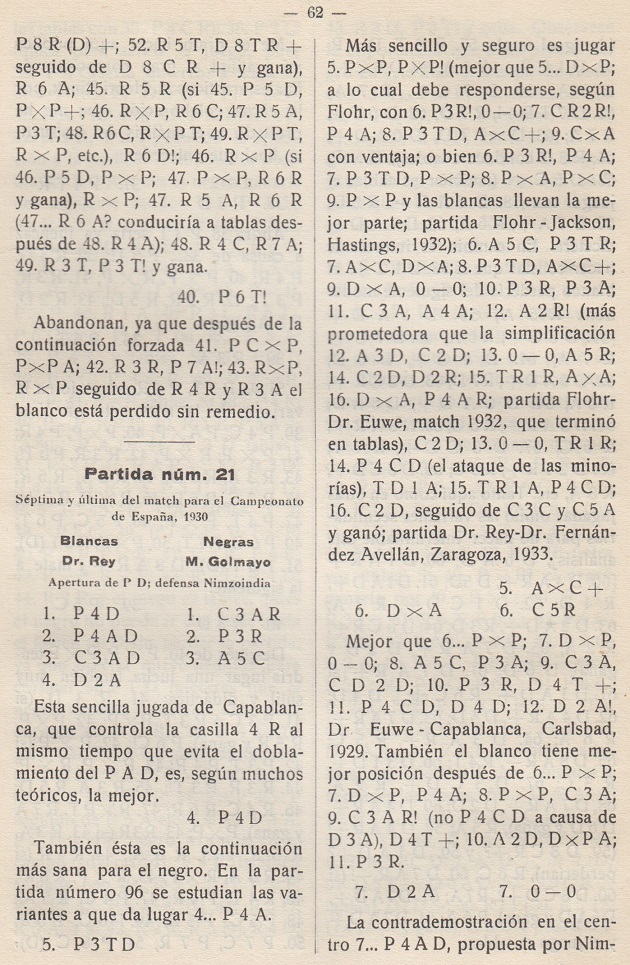
1 d4 Nf6 2 Nf3 e6 3 e3 b6 4 Bd3 Bb7 5 Nbd2 c5 6 c3 Nc6 7 e4 cxd4 8 cxd4 Nb4 9 Bb1 Ba6 10 e5 Nfd5 11 Ne4 Qc7 12 a3 Nc6 13 Bd3 Bxd3 14 Qxd3 Be7 15 O-O f5 16 Nc3 Nxc3 17 Qxc3 Qb7 18 b4 Bd8 19 Bg5 Bxg5 20 Nxg5 O-O 21 Rac1 Rac8 22 Qb2 Ne7 23 Rxc8 Rxc8 24 Rc1 Nd5 25 Nf3 Rxc1+ 26 Qxc1 Qc7 27 Qxc7 Nxc7 28 Ne1 Kf7 29 Kf1 Ke7 30 Ke2 d6 31 Kd3 Kd7 32 Nc2 g5 33 exd6 Kxd6 34 Ne3 b5 35 f3 Nd5 36 Nxd5 Kxd5 37 Kc3 h5 38 Kd3 h4 39 Kc3 g4 40 Kd3 h3 41 White resigns.
11126. Carlsen v Caruana e-book
Olimpiu G. Urcan (Singapore) draws our attention to his review of the e-book Carlsen v Caruana: FIDE World Chess Championship, London 2018 by Raymond Keene and Byron Jacobs (London, 2018) and sends us half a dozen lines from the book’s ‘History of the World Championship’ section:

We offer a few comments:
- Anderssen’s opponent in the Immortal Game ‘of London 1851’ was Kieseritzky, a name which Raymond Keene has persisted in misspelling for decades.
- The Evergreen Game was not ‘against the pseudonymous Dufresne (in reality the German player E.S. Freund)’. Dufresne was his name, and E.S. Freund was his pseudonym. Raymond Keene made the same obvious gaffe 30 years ago, on page 136 of his Pocket Book of Chess (London, 1988), as pointed out in C.N. 10155. See too Cuttings.
- Anderssen v Dufresne was not played in 1856. Our feature article on the game shows that it was published on pages 338-339 of the September 1852 Deutsche Schachzeitung.
- Anderssen v Zukertort was played in Barmen, not Breslau.
Even without primary sources, a quick glance at, for instance, The Oxford Companion to Chess by D. Hooper and K. Whyld (Oxford, 1992) would have sufficed to avoid all these elementary blunders.
11127. Journalistic folly
From page 3 of the Chess Amateur, October 1925:
‘To the folly of the lay journalist writing about chess there is no end.’
11128. Brin-Jonathan Butler (C.N. 11084)
An extreme example of a chess book treating the leading players of the past without respect is The Grandmaster by Brin-Jonathan Butler (New York, 2018). From page 133, this is the sum total (Wikipedia-based, of course) of what the book offers on Nimzowitsch:
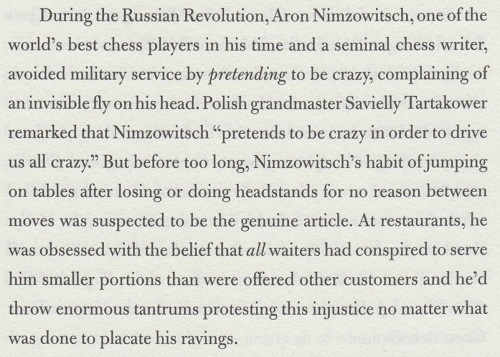
11129. The Australian Nimzowitsch
The nickname for F.A. Crowl, ‘the Australian Nimzowitsch’, was the heading to his game against L. Steiner in the 1936-37 Australian championship in Perth on page 57 of the Australasian Chess Review, 27 February 1937.
11130. A new Lasker book
Everyman Chess has just brought out Lasker move by move by Zenón Franco (London, 2018):
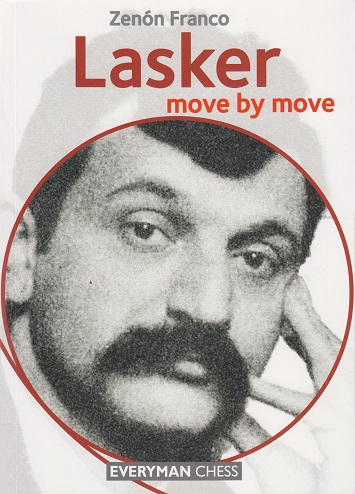
It arrived this morning, and we have not yet progressed beyond the desperately superficial bibliography on page 5 and the welter of unsourced quotes by and about Lasker on pages 9-12.
11131. Reinfeld and Chernev on Steinitz
From page 11 of Chess Strategy and Tactics by Fred Reinfeld and Irving Chernev (New York, 1933):
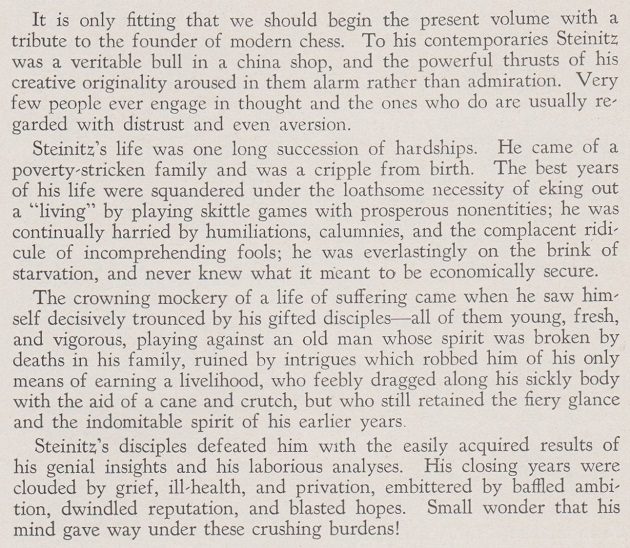
11132. Fairy chess
Further to The Knight Challenge, Michael McDowell (Westcliff-on-sea, England) writes:
‘Fairy chess enthusiasts divide pieces into riders, leapers and hoppers, although this does not by any means cover all unorthodox pieces. Riders can move any distance along a line unless obstructed (e.g. bishop, rook, queen), leapers move directly to a square ignoring any obstacle, and hoppers need a hurdle to jump over in order to move. Hence the knight is succinctly described as a 2,1 leaper. There are numerous unorthodox examples, such as the camel (a 3,1 leaper) and the root-50 leaper (which combines two lengths of move, being a 5,5 or 7,1 leaper).’
Our correspondent furthermore draws attention to the definitions on pages 8-9 of A Guide to Fairy Chess by Anthony Dickins (Richmond, 1969 and New York, 1971). The first edition was published in Richmond in 1967.
11133. Chess and draughts/checkers
From Arie van der Stoep (Hooge Zwaluwe, the Netherlands):
‘As shown on my website, I have carried out a comparative investigation into the social position of chess, draughts and other board games. Chess historians have, unfortunately, neglected it, but how can one establish the popularity of a game without comparative research?’
See too Chess and Draughts/Checkers.
11134. Oversights
From pages 25 and 110 of Blunders and Brilliancies by Ian Mullen and Moe Moss (Oxford, 1990):

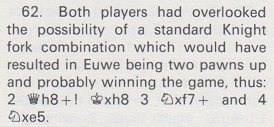
Before discussing blunders in the game, we point out one in the book: Alekhine was White.
The series of oversights by Alekhine and Euwe was discussed on page 131 of CHESS, 14 December 1937. Here is that text as reproduced on page 45 of the book The World-Championship Match by B.H. Wood (Sutton Coldfield, 1938):
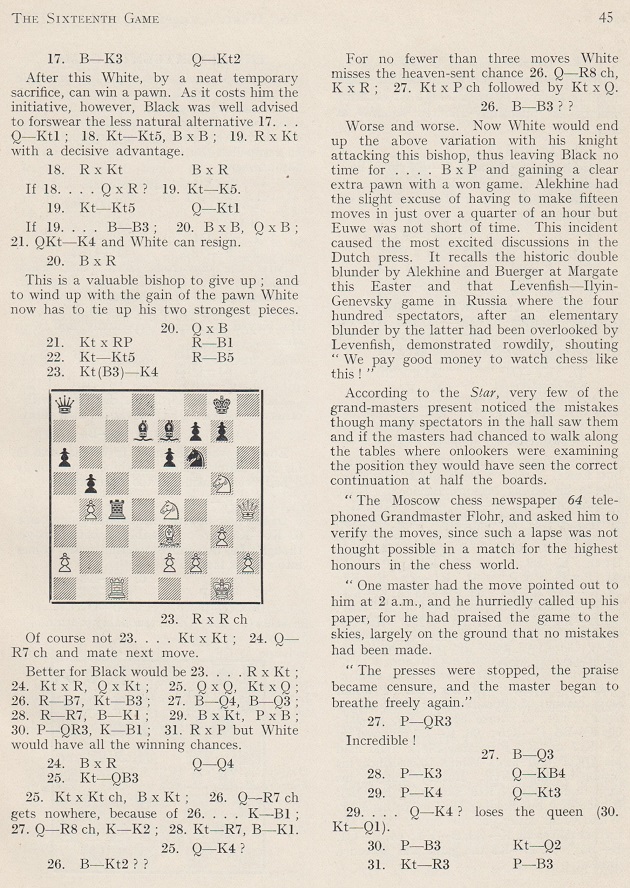
Information about the reference to the Star in the note to Black’s 26th move will be appreciated.
From pages 113-114 of Alekhine’s book The World’s Chess Championship 1937 (London, 1938):
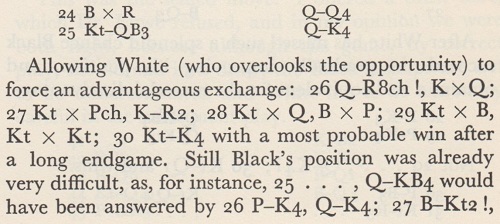
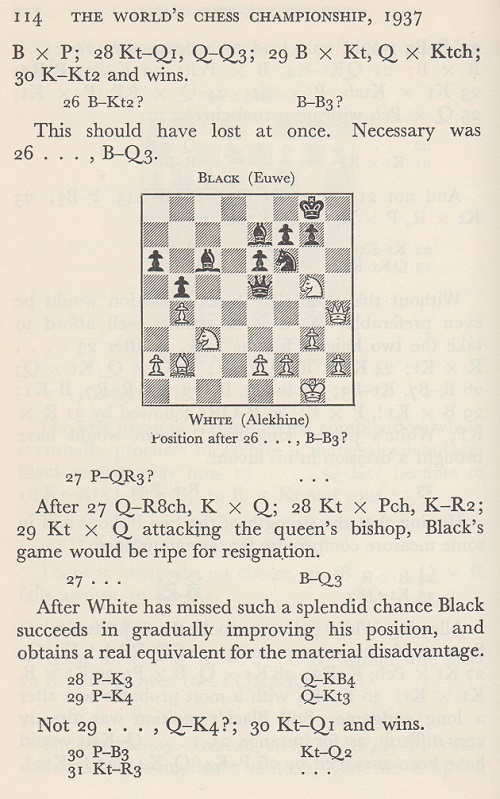
Below are those notes of Alekhine’s as published on pages 61-62 of Euwe-Aljechin 1937 by M. Euwe and A. Alekhine (Leiden, 1938):
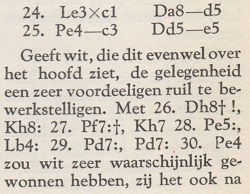
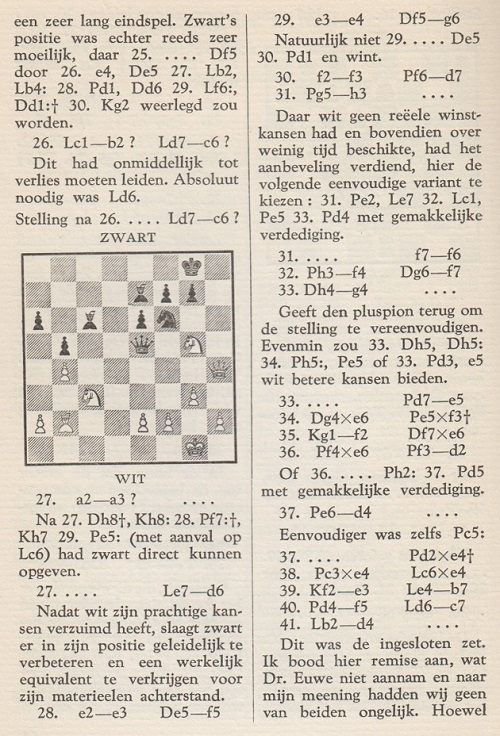
The game was annotated by Adolf Seitz on pages 116-117 of the American Chess Bulletin, November-December 1937 with this comment on the adjournment position (after 40...Bc7):
‘Notwithstanding that the newspapers in the Netherlands reported that Dr Euwe had the better position, the game ended eventually in a draw. A certain Dr Tartakower writing in the Telegraaf, failed to mention the combination beginning with 26 Q-R8ch! May Caissa veil your head!’
The game was played in Rotterdam on 11 and 12 November 1937. The relevant part of Tartakower’s annotations on page 5 of De Telegraaf, 12 November 1937:
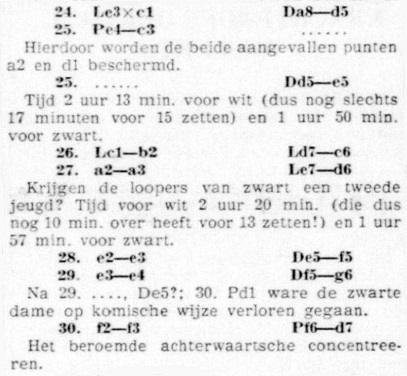
Towards the beginning of his report in the following day’s edition (page 5) Tartakower referred to the series of mistakes on moves 25-27:

Did other Dutch newspapers of the time have further information?
11135. Chess maxims
Reproduced without comment from pages 57-58 of Chess by Kenneth M. Grover and Thomas Wiswell (London, 1952):
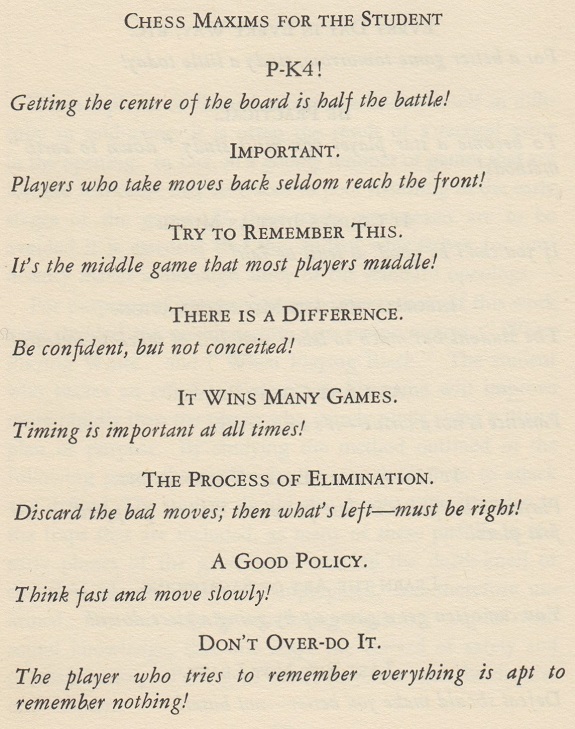
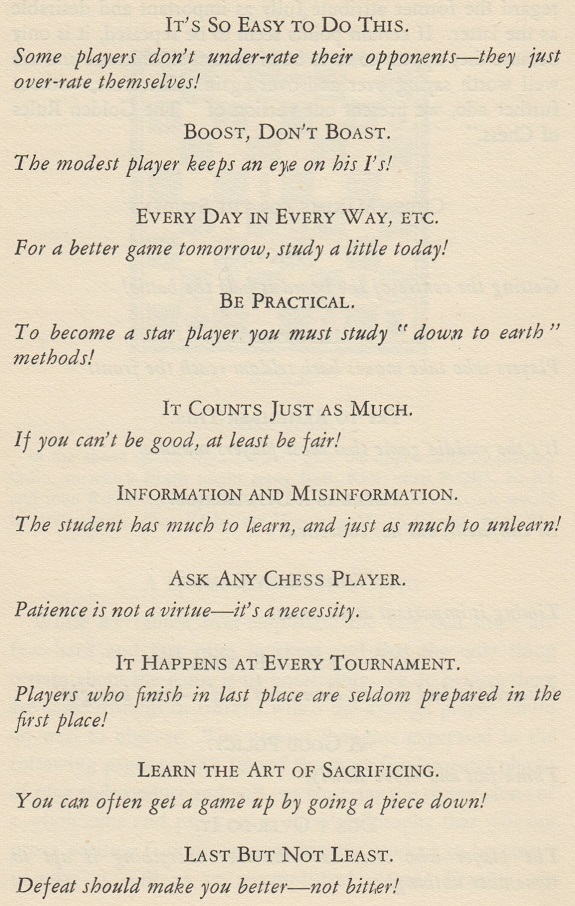
11136. Steinitz brilliancy
‘The best years of his life were squandered under the loathsome necessity of eking out a “living” by playing skittle games with prosperous nonentities ...’
Regarding this comment about Steinitz by Reinfeld and Chernev in C.N. 11131, Eduardo Bauzá Mercére (New York, NY, USA) writes:
‘At least he could exercise his tactical prowess against them, as in the following game:’
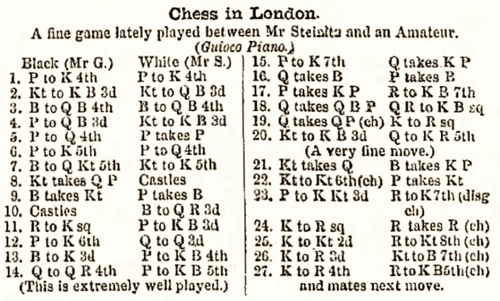
Source: The Era, 25 June 1871, page 7.
1 e4 e5 2 Nf3 Nc6 3 Bc4 Bc5 4 c3 Nf6 5 d4 exd4 6 e5 d5 7 Bb5 Ne4 8 Nxd4 O-O 9 Bxc6 bxc6 10 O-O Ba6 11 Re1 f6 12 e6 Qd6 13 Be3 f5 14 Qa4
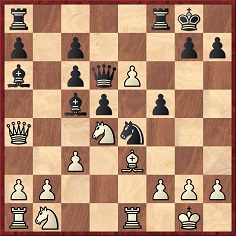
14...f4 15 e7 Qxe7 16 Qxa6 fxe3 17 fxe3 Rf2 18 Qxc6 Raf8 19 Qxd5+ Kh8 20 Nf3
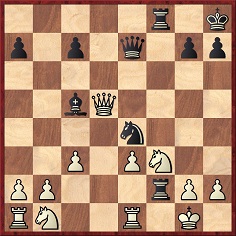
20...Qh4 21 Nxh4 Bxe3 22 Ng6+ hxg6 23 g3 Re2+ 24 Kh1 Rxe1+ 25 Kg2 Rg1+ 26 Kh3 Nf2+ 27 Kh4 Rf4+ 28 White resigns.
11137. Alekhine v Euwe (C.N. 11134)
Rudy Bloemhard (Apeldoorn, the Netherlands) writes:
‘The Dutch website Delpher shows that many of the country’s newspapers dated 12 November 1937 shared the same analysis, including references to Alekhine’s severe time-trouble. An example is Twentsch Dagblad Tubantia, fourth section, page 1:
The note after 27 a3 states that it was only at that point that Euwe was seen to turn his attention to “the endangered corner of the board”, after which “a sigh of relief went through the playing hall”.
From page 1 of Het Vaderland:
My translation of the paragraph about time-trouble:
“Be that as it may, the fact is that the world champion achieved excellent counter-play, added to which was the circumstance that Alekhine started to be in serious time-trouble (the complicated position had caused him many headaches). That it was not only Alekhine who was nervous, but also the always seemingly calm Euwe, can be deduced from the fact that for two moves both players missed the sacrifice Qh8+ (possible on move 26 and even stronger on move 27). From Alekhine, who feverishly and fearfully checked his clock, this was more understandable than from Euwe, who had more than enough time.”’
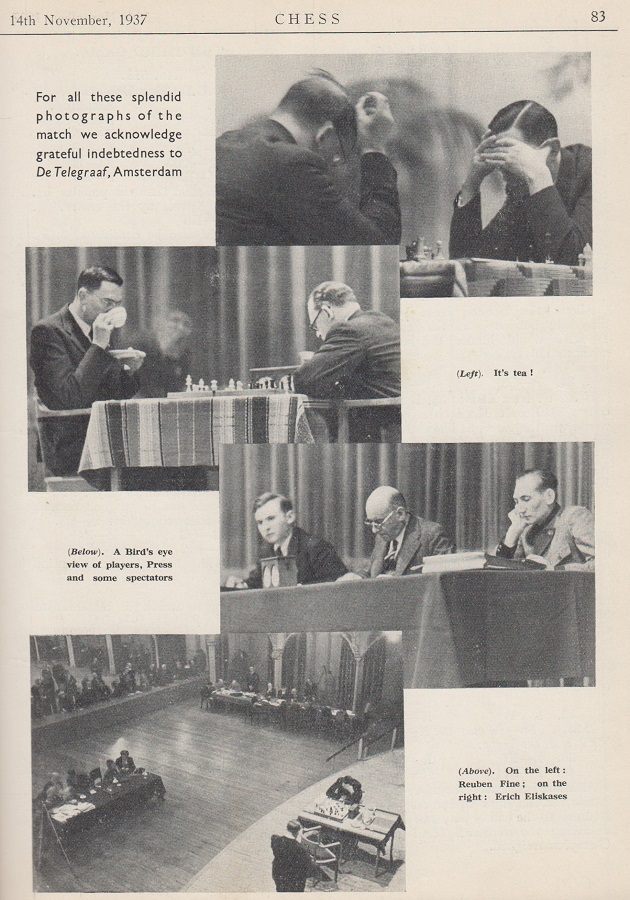
We add an excerpt from page 13 of The Chess Mind by Gerald Abrahams (London, 1951):
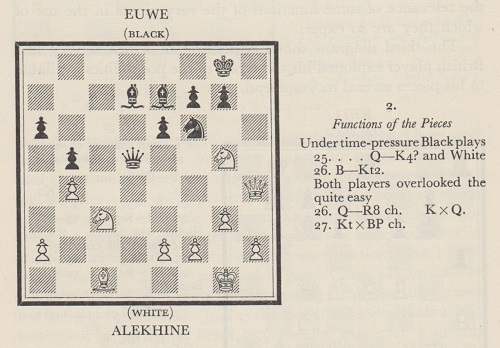
As already demonstrated, it was Alekhine, not Euwe, who was short of time.
Writers wishing to revel in world champions’ lapses may choose to ignore the issue of clock-pressure. See, for instance, pages 29-30 of The Inner Game of Chess by A. Soltis (New York, 1994) and pages 140-141 of the same author’s Chess Lists (Jefferson, 2002).
A sample comment from the latter book, after 27 a3:
‘Black continues to allow – and White continues to miss – the Qh8+ combination, the kind most 1800-rated players would find quickly.’
It may be pointed out, however, that Alekhine’s own annotations to the game, in his match book, had only one reference to the clock, and it was later in the game: he stated that at move 31 he ‘was very short of time’. Alekhine’s general view about time-shortage not being an excuse may be recalled from C.N.s 7973 and 10354.
11138. Rudolf-Spielmann-Platz
James Bell Cooper (Vienna) sends a photograph which he took in the Austrian capital on 15 December 2018:

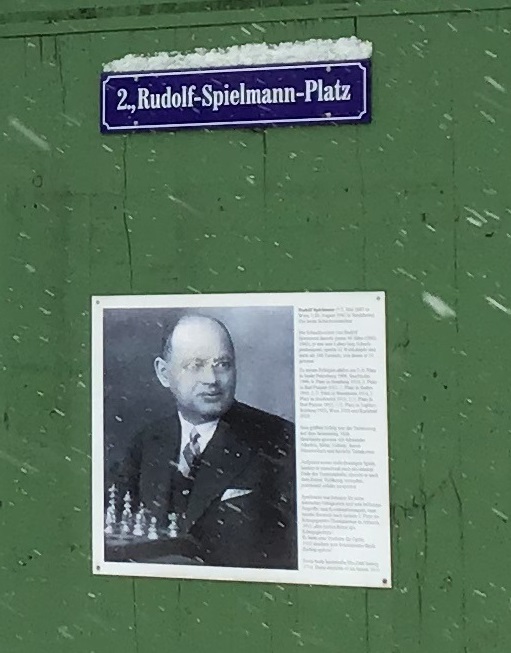
11139. Lasker v Tarrasch, 1908
Discussing the Lasker v Tarrasch world title contest, page 247 of Lasker move by move by Zenón Franco (London, 2018) has the phrase ‘the “Match of the Century”, as it was called at the time’.
Called by whom?
11140. Lasker v Janowsky, 1909
Page 298 of Z. Franco’s book on Lasker shows his awareness that the only world title match between Lasker and Janowsky was in Berlin in late 1910.
However, the following is on page 23:
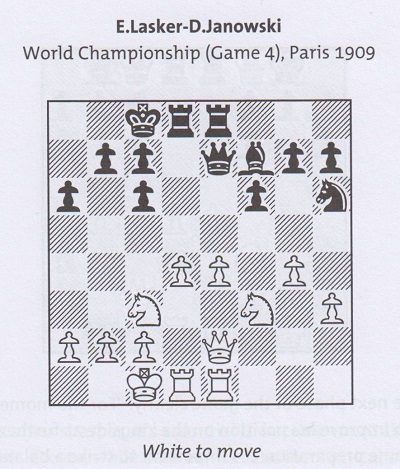
This was merely the last encounter in a four-game match in May 1909. From the report on page 167 of the May 1909 issue of La Stratégie:
‘... M. Nardus, le généreux promoteur du match-revanche Janowski-Marshall, offrit au Champion de subventionner un match entre lui et D. Janowski. A la suite de quelques pourparlers, une lutte importante fut remise à plus tard, mais les conditions d’une courte rencontre immédiate furent ainsi établies: quatre parties seulement; les nulles comptant pour demi-point; 1.000 fr. au vainqueur plus 750 fr. à chacun des deux maîtres.
Commencé le 12 mai en la villa Léa, à Suresnes, ce match s’est terminé le 22 du même mois, avec le résultat négatif de deux parties gagnées par chacun.’
The venue was the residence of Léonardus Nardus. See too Lasker v Janowsky, Paris, 1909.
11141. ‘An Unhonoured Genius’
Which chess master drew a 20-game world title match against Steinitz, also defeating Zukertort by ten games to two, Lasker by ten games to five, and Mason by ten games to zero?
There was obviously no such player, yet those claims, by G.J. Kelly of Leicester, were published on page 404 of CHESS, 9 July 1955:
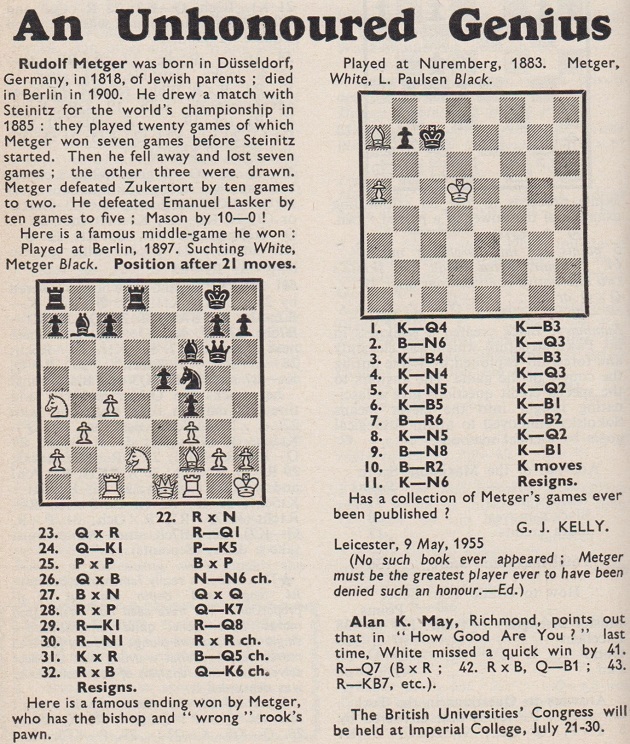
A correction appeared on page 444 of the 20 August 1955 issue:
‘The “Rudolf Metger” mentioned in a letter on page 404 of our issue of 9 July never existed. We are informed by his daughter that Mr G.J. Kelly, writer of the letter, is in hospital, a very sick man indeed. Unfortunately, due to pressure of work connected with the Southend Festival, we omitted our normal check-up.’
Rather than a ‘normal check-up’, a split-second glance at G.J. Kelly’s letter should have been enough.
The first position was from the game between Hugo Süchting and Johannes Metger, Berlin, 30 September 1897, as given on pages 144-145 of Warren H. Goldman’s tournament book (Düsseldorf und Kempten/Allgäu, 1966). Johannes Metger v Paulsen, Nuremberg, August 1888 was discussed in C.N.s 9897, 9902 and 9927.
The ‘Rudolf Metger’ matter was related, with some speculation, by K. Whyld on page 29 of CHESS, March 2002. From page 199 of Kagans Neueste Schachnachrichten, January-March 1926:
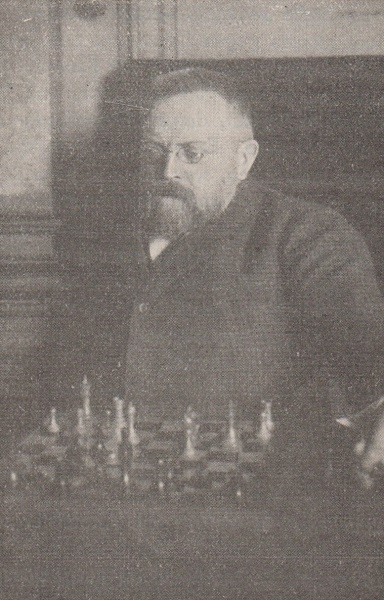
Johannes Metger (1851-1926)
11142. Stuffing, guts and dents
In addition to its many factual errors, Carlsen v Caruana: FIDE World Chess Championship, London 2018 by Raymond Keene and Byron Jacobs (London, 2018) has much copying from other works by Mr Keene. A note at the end of the review mentioned in C.N. 11126 observes:
‘About 90% of the biographies of Lasker, Capablanca and Alekhine is a direct copy from Keene’s book on the 2000 world championship.’
Another example is the biographical section on Spassky, where even the misspelling ‘he gave full reign’ is repeated. From that section (pages 27-28) we highlight one sentence, concerning the 1972 world championship match:
- ‘The battering Spassky received in that match knocked the stuffing out of him.’
In reverse chronological order:
- ‘The battering Spassky received in that match knocked the guts out of him.’
Page 35 of The Brain Games World Chess Championship by Raymond Keene and Don Morris (London, 2000).
- ‘The battering Spassky received in that match knocked the guts out of him.’
Page 178 of Samurai Chess by Michael Gelb and Raymond Keene (London, 1997).
- ‘The battering which Spassky received at the tournament [sic] knocked the guts out of him.’
Page 21 of part 5 of Raymond Keene’s Men of War publication for The Times during the 1993 Kasparov-Short match.
- ‘Perhaps the western media exposure, to which Spassky, being a Russian, was quite unaccustomed, helped to knock the stuffing out of him.’
Page 72 of Chess for Absolute Beginners by Raymond Keene (London, 1993).
- ‘Perhaps the Western press exposure, to which Spassky, being a Russian, was quite unaccustomed, helped to knock the stuffing out of him.’
Page 10 of Fischer-Spassky II by Raymond Keene (London, 1992).
- ‘The battering which Spassky received, sadly knocked the guts out of him.’
Page 96 of Chess An Illustrated History by Raymond Keene (London, 1990).
- ‘It seems that Fischer knocked the guts out of him.’
Page 223 of Warriors of the Mind by Raymond Keene and Nathan Divinsky (Brighton, 1989).
A sub-variation:
- ‘The battering Spassky received in that match severely dented his resolve and self-confidence.’
Page 107 of Carlsen-Anand Match for the World Chess Championship by Raymond Keene (New York, 2013).
- ‘The mental battering Spassky received in that match, on and off the board, severely dented his resolve and self-confidence.’
Page 25 of Battle of Bonn by Raymond Keene and Eric Schiller (2008).
- ‘The mental battering Spassky received in that match, on and off the board, severely dented his resolve and self-confidence.’
Page 50 of Vishy’s Victory by Raymond Keene (2007).
- ‘The mental battering Spassky received in that match, on and off the board, severely dented his resolve and self-confidence.’
Page 58 of World Chess Championship Kramnik vs. Leko by Raymond Keene (Aylesbeare, 2004).
11143. Guillermo Puiggrós
Eduardo Bauzá Mercére (New York, NY, USA) sends from his personal collection two photographs of Guillermo Puiggrós taken at open tournaments in 1977 in, respectively, Buenos Aires (Ferro Carril Oeste) and Mar del Plata:

From pages 63-64 of his book Brillantes partidas argentinas (Buenos Aires, 1977) we reproduce the section by Puiggrós about himself:
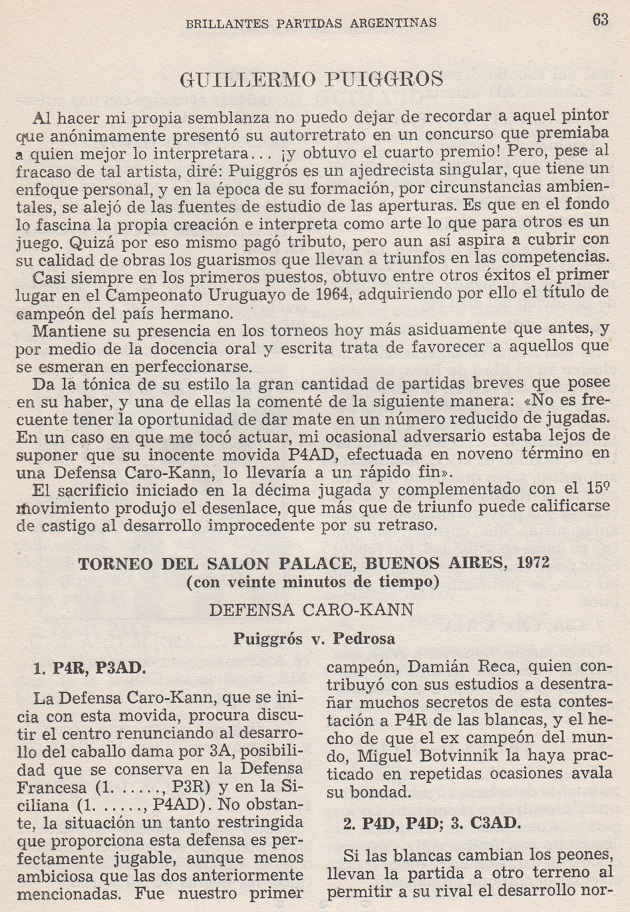
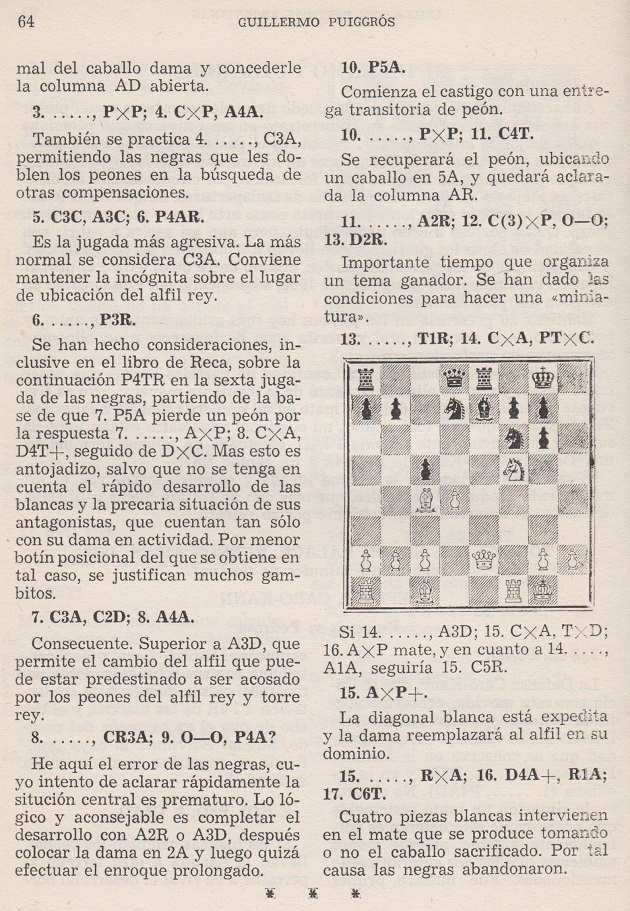
1 e4 c6 2 d4 d5 3 Nc3 dxe4 4 Nxe4 Bf5 5 Ng3 Bg6 6 f4 e6 7 Nf3 Nd7 8 Bc4 Ngf6 9 O-O c5 10 f5 exf5 11 Nh4 Be7 12 Ngxf5 O-O 13 Qe2 Re8 14 Nxg6 hxg6 15 Bxf7+ Kxf7 16 Qc4+ Kf8 17 Nh6 Resigns.
11144. Pawn sacrifices (C.N. 9859)
A comment on page 45 of Chess Strategy and Tactics by Fred Reinfeld and Irving Chernev (New York, 1933):
‘From the aesthetic point of view, there are few effects in chess so pleasing as a subtly planned and skillfully executed pawn sacrifice. The more unobtrusive the move, the less obvious – all this contributes to its artistry.’
11145. Lasker v Tarrasch, 1908
From pages 486-487 of the November 1908 BCM:
‘Thus the match, which the German Schachbund took such pains to bring about, was veritably an encounter of giants, and justified the widespread interest that was taken in it. Surely never before has the daily press devoted so much attention to our game. All over the world – even in far-away Japan – the course of the match was followed with close interest, and no doubt the circle of chessplayers has been greatly widened by the unique advertisement thus given to the game.
Apart from the heavy monetary prize at issue, both players had a still greater incentive to exert their best efforts in the reputation that they staked. Until the verdict of an actual encounter with Tarrasch had been given, the German chess world was loth to concede the title of world champion to Lasker. To the majority of German chessplayers Dr Tarrasch appeared invincible, and it must be confessed he himself seemed to share the opinion. Lasker, of course, had the glory and the pecuniary value of his title to defend.’
11146. The Corkscrew Counter-Gambit
An assertion about The Oxford Companion to Chess (Oxford, 1984) on page 35 of The Times, 7 August 2003, in an obituary of Kenneth Whyld:
‘... there are wonderful titbits of chess trivia, such as a disquisition on the little-known and almost never employed corkscrew counter gambit.’
In reality, the disquisition (dictionary definition: ‘a long complicated speech or written report on a particular subject’) on page 79 of The Companion was merely the following:

The reference ‘543’ relates to the following moves in the openings chart on page 401: 1 e4 e5 2 Nf3 f5 3 Nxe5 Nf6 4 Bc4 fxe4 5 Nf7 Qe7 6 Nxh8 d5.
Those moves appeared without comment on pages 150-151 of Mr Blackburne’s Games at Chess by P. Anderson Graham (London, 1899), in Gamman v Blackburne, London, 1869. The previous game, on pages 149-150, was between the same players and began 1 e4 e5 2 Nf3 f5 3 Nxe5 Nf6 4 Bc4 fxe4 5 Bf7+, with this note after White’s fifth move:
‘For the effect of Kt-B7 see next game. This defence was jocularly called the “Corkscrew Gambit”.’
5 Nf7 was linked to the name in The Chess Player’s Compendium by William Cook. Below, for instance, is page 7 of the fifth edition (Philadelphia, 1910):
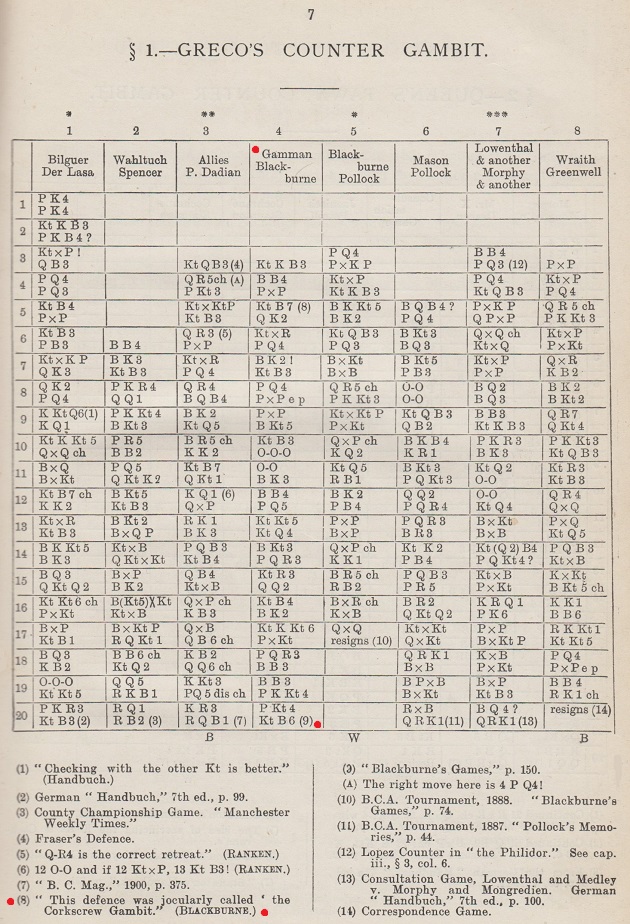
We also note a Cook v Blackburne game on page 74 of Synopsis
of
the
Chess Openings by William Cook (London, 1874), where
the ‘Corkscrew Gambit’ move was identified as 3...Nf6 and,
again, there was no claim that the name had been coined by
Blackburne.
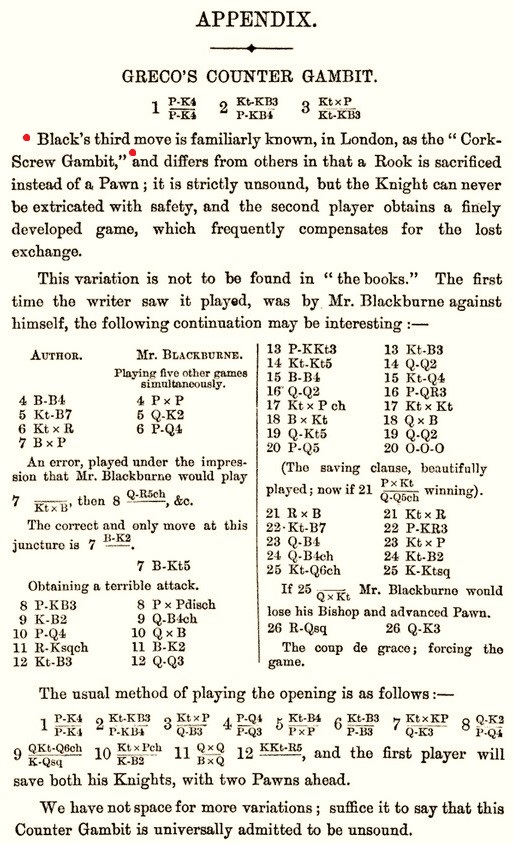
1 e4 e5 2 Nf3 f5 3 Nxe5 Nf6 4 Bc4 fxe4 5 Nf7 Qe7 6 Nxh8 d5 7 Bxd5 Bg4 8 f3 exf3+ 9 Kf2 Qc5+ 10 d4 Qxd5 11 Re1+ Be7 12 Nc3 Qd6 13 g3 Nc6 14 Nb5 Qd7 15 Bf4 Nd5 16 Qd2 a6 17 Nxc7+ Nxc7 18 Bxc7 Qxc7 19 Qg5 Qd7 20 d5

20...O-O-O 21 Rxe7 Nxe7 22 Nf7 h6 23 Qf4 Nxd5 24 Qc4+ Nc7 25 Nd6+ Kb8 26 Rd1 Qe6 and wins.
Can readers assist in taking this matter forward?
11147. The number of chessplayers
On the topic of How Many People Play Chess?, below is a paragraph from page 368 of Lasker’s Manual of Chess (New York, 1927), in the chapter entitled ‘Final reflections on education in chess’:
‘Most chessplayers slowly climb to a certain rather low level and stay there. Of players to whom a master can give the odds of the queen there are millions; players of greater skill count probably no more than a quarter of a million. If we reckon the number of rook-odds players as a hundred and fifty thousand, of knight-odds players as fifty thousand, of pawn and two-move odds players as forty thousand, of pawn and move odds players as nine thousand, and the number of those to whom no master can allow odds as one thousand, we are likely not to be far wrong.’
The wording was slightly different on page 336 of the more readily available 1932 and 1947 editions, but the figures were the same.
11148. Underpromotion
Our latest feature article is Underpromotion in Chess.
11149. Gamelets
C.N.s 2257 and 3382 had two gamelets with a similar motif. The first, Fraser v N.N. (see pages 144-145 of A Chess Omnibus), was taken from page 40 of Revue d’échecs, November 1902:

From page 634 of the Illustrated London News, 24 December 1881:

1 e4 d5 2 e5 d4 3 Bd3 Nd7 4 e6 fxe6 and White mated in three moves.
C.N. 2257 raised the question of whether after 5 Qh5+ g6 ...
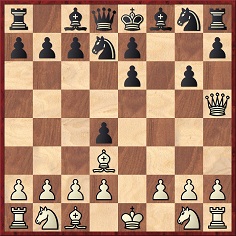
... the heavyweight sacrifice 6 Qxg6+ is more ‘aesthetically pleasing’ than the restrained 6 Bxg6+ line. For other positions relevant to this topic see page 145 of A Chess Omnibus, as well as page 9 of Chess Facts and Fables (C.N. 3034).
Information about ‘the late Dr Fraser, of Edinburgh’ and the occasion of the game is still being sought.
The second game (Ressel v Piperno) was given in C.N. 3382 (see page 62 of Chess Facts and Fables):
1 f3 e6 2 h4 Bd6 3 Rh3 Qxh4+ 4 g3
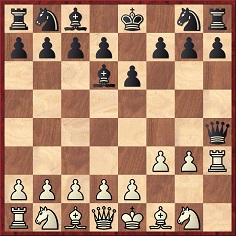
4...Bxg3+ 5 Rxg3 Qxg3 mate.
As mentioned in C.N. 3382, 4…Qxg3+ would have given a five-move game with two consecutive queen sacrifices.
Our source was the American Chess Bulletin, January 1934, page 10:

We add now that the score was also published by Hermann Helms on page 22 of the Brooklyn Daily Eagle, 18 January 1934:
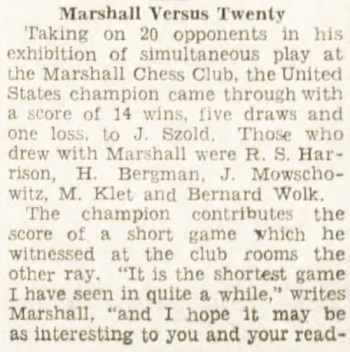

The wording in the Brooklyn Daily Eagle indicates that the game was played in January 1934.
11150. EEC/EU chess events
Page 14 of Europe Echecs, July-August 1983:
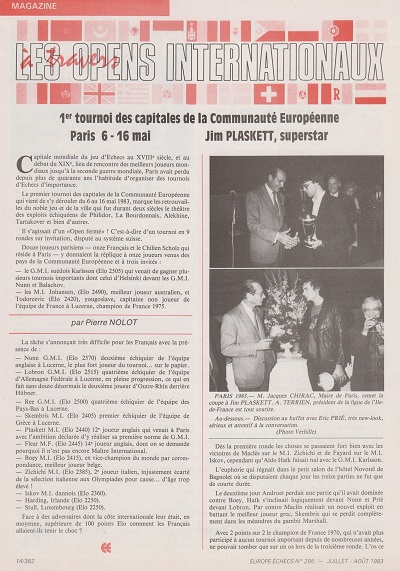
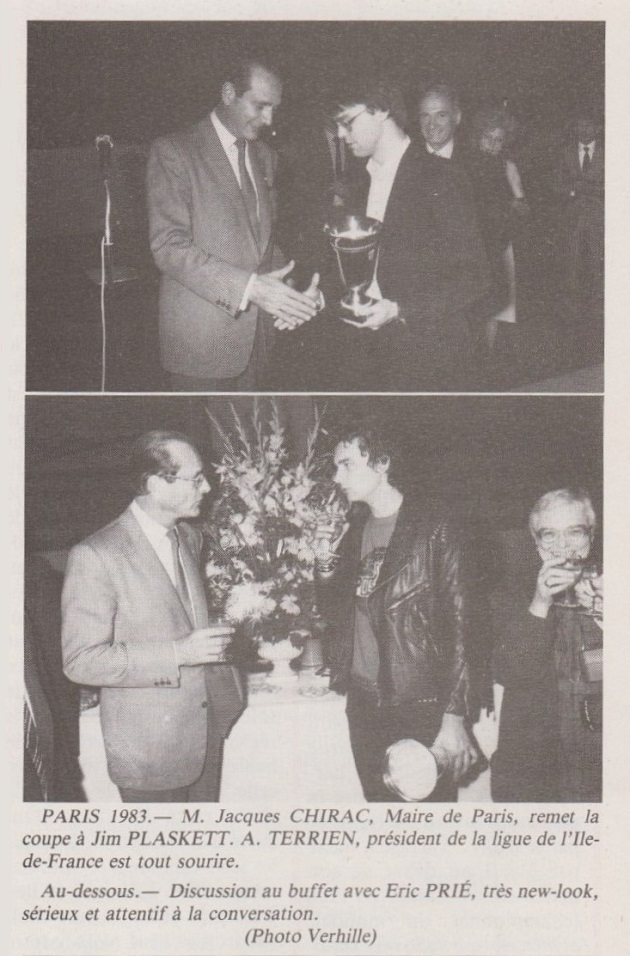
An interview with the organizer, Jean-Pierre Girard, on pages 16-17 mentioned that the European Economic Community had participated in funding the tournament.
An earlier contest that comes to mind is the First Team Championship of the European Economic Community in Ostend, September 1975. It involved all nine Member States and was won by the Netherlands. The reports that we have consulted (e.g. on pages 517-518 of the December 1975 BCM) indicate no specific involvement by the European body.
Information about notable chess events connected with the European Economic Community/European Union will be welcomed.
11151. Equality
A strange definition of equality on page 94 of An illustrated Dictionary of Chess by Edward R. Brace (London, 1977):
‘A situation existing when neither side has a decisive advantage.’
11152. CHESS The Musical
Concerning CHESS The Musical, at the end of November 2018 the curators of the Digital Collections of the New York Public Library added a fine set of photographs. The precise source is Martha Swope Photographs Collection, available via the Billy Rose Theatre Division.
11153. David Robb
Page 299 of CHESS, 4 August 1956 referred to ‘David Robb, editor of one of America’s greatest chess columns, that in the Cleveland Plain Dealer’.
Wanted: information about Robb and some highlights from his column.
11154. Vassily Soldatenkov
From Vitaliy Yurchenko (Uhta, Russian Federation):
‘Pages 80-85 of the 12/2018 issue of 64 – Шахматное обозрение have a detailed, illustrated article about V. Soldatenkov by Stanislav Sukhanitsky of Lubny, Ukraine.’
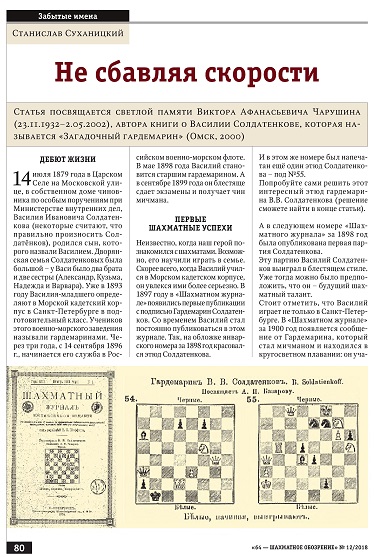
11155. Janowsky on Emanuel Lasker
Two books by Edward Lasker quoted a conversation with Janowsky in Berlin in 1910, at the time of the latter’s world title match against Emanuel Lasker.
From page 101 of The Adventure of Chess (New York, 1950):
‘Instead of admitting that he spent his nights at roulette, he said to me one day: “I don’t think I will win a game in this match. Lasker plays too stupidly for me to look at the board with any interest.”’
From page 115 of Chess Secrets I Learned from the Masters (New York, 1951):
‘After losing the first three games of the match, he said to me: “Your namesake plays such stupid chess that I simply cannot look at the board while he is thinking. I am afraid I shan’t do well in this match at all.”’
Edward Lasker’s statements on chess history require caution. For example, page 101 of The Adventure of Chess placed both of the longer Lasker v Janowsky matches in Berlin. On that point, page 88 of Chess Secrets I Learned from the Masters was correct (the former ‘took place in Paris in the fall of 1909’) but wrongly asserted that it was for the world title.
11156. How to pronounce Nimzowitsch
Throughout Chess Secrets I Learned from the Masters Edward Lasker used the spelling ‘Nimzóvich’, indicating stress on the second syllable. On page 241 of the August 1947 BCM Jacques Mieses referred to ‘Aron Niemzowitsch – four syllables with the accent on the last but one, thus: Ni-em-zó-witsch After 1920, however, he called himself willy-nilly Nimzowitsch’.
The pronunciation ‘Nimzó-Indian’ could be regarded as the logical consequence.
11157. Zukertort in Cincinnati
Page 8 of the Cincinnati Enquirer, 9 April 1884 has another example (see C.N.s 5465 and 7112) of Zukertort being called the world chess champion:
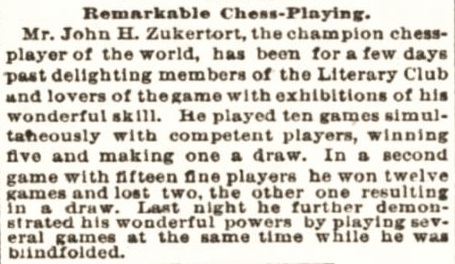
Zukertort’s visit to Cincinnati was referred to in C.N. 5773, with mention of a loss to Ettlinger.
Page 115 of the Brooklyn Chess Chronicle, 15 May 1884 stated that he was defeated by Ettlinger in a 25-board simultaneous exhibition on 6 April and in a six-board blindfold display two days later. Pages 124-125 gave the score of a victory by Ettlinger, headed ‘one of Dr Zukertort’s simultaneous games in Cincinnati’:
1 e4 e5 2 Nc3 Nc6 3 Nf3 Nf6 4 Bb5 d6 5 d4 Bd7 6 O-O h6 7 Bxc6 Bxc6 8 dxe5 Nxe4 9 exd6 Qxd6 10 Qe2 f5 11 Nd2 O-O-O 12 Ncxe4 fxe4 13 Nxe4 Qg6 14 Ng3 h5 15 f3 Bc5+ 16 Kh1 h4 17 Ne4 Rhe8 18 Bf4

18...h3 19 Rae1 Rd4 20 Bg3 Rdxe4 21 fxe4 Rxe4 22 White resigns.
11158. Thomas v Macdonald
Page 120 of Womanhood, 1904 had a correspondence game between George Alan Thomas and Ronald Cadell Macdonald:


1 e4 e5 2 Nf3 Nf6 3 Nxe5 d6 4 Nf3 Nxe4 5 d4 d5 6 Bd3 Nc6 7 O-O Be7 8 Re1 Bg4 9 c3 Nf6 10 Bf4 O-O 11 Nbd2 Bd6 12 Bg5 Ne7 13 Qc2 Ng6 14 Ne5 Bc8 15 Re3 h6 16 Bxf6 Qxf6 17 Rf3 Nf4
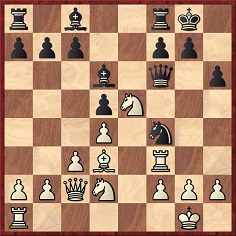
18 Re1 Qh4 19 g3 Nh3+ 20 Kh1 Qg5 21 Bh7+ Resigns.
11159. Was Alexander McDonnell a soldier?
From John Townsend (Wokingham, England):
‘Is anything at all known about the physical appearance of Alexander McDonnell, or about what he did before embarking upon his career as a merchant? A little information can perhaps be gleaned from a Royal Artillery drivers’ description book deposited in the National Archives at Kew (WO 69/654).
Folio 37 includes, on the fifth line, an entry for the driver Alexr McDonell [sic], who was enlisted by Lieutenant Clark on 1 February 1814, in Lisburn (Ireland), aged 15. He is described as five feet three inches in height, with a swarthy complexion, brown hair and blue eyes, having been born in Belfast, in the county of Antrim. He had no trade or calling, and was first mustered in the 7th Battalion, posted to Troop “B”. He was discharged on 28 February 1817 in Ireland.
Was this driver the celebrated chessplayer? His name, age and place of birth are all plausible, but would one not expect the son of a merchant to join the army as an officer?
In C.N. 10662 the father of the chessplayer was identified as Thomas McDonnell (/MacDonnell), a merchant. James O’Fee, in his article Still Researching Alexander McDonnell 2010: Part 4, cited a death notice in the Belfast News Letter announcing that Mr Thomas M’Donnell, a merchant of Belfast, had died on 17 January 1809.
The website Findagrave reports a memorial in Knockbreda Cemetery, Belfast to a Thomas McDonnell who died on that date.
The same memorial also records Mary McDonnell (1767-98), the wife of Thomas. From this one might infer that the chessplayer’s mother died at approximately the time, i.e. 1798, when, his own 1835 burial record suggests, he was born. The possibility arises of her death in child-birth. It may also be concluded that Alexander McDonnell became an orphan in 1809, following his father’s death, and in those circumstances a spell as a driver in the Royal Artillery becomes less difficult to envisage. Meanwhile, more evidence is needed to determine whether the young soldier in the record book became the man who was later famous as the adversary of Labourdonnais.’
11160. A blindfold miniature by John Warcup Cornforth
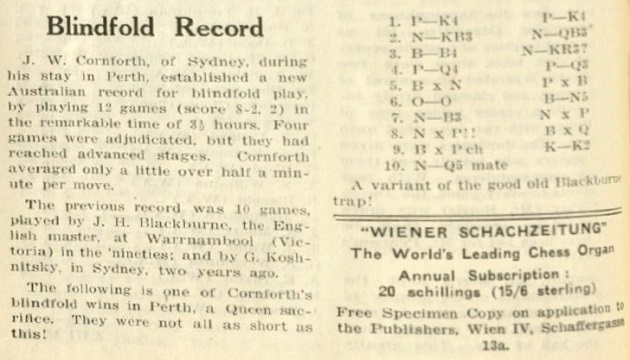
Australasian Chess Review, 27 February 1937, page 26
1 e4 e5 2 Nf3 Nc6 3 Bc4 Nh6 4 d4 d6 5 Bxh6 gxh6 6 O-O Bg4 7 Nc3 Nxd4 8 Nxe5 Bxd1 9 Bxf7+ Ke7 10 Nd5 mate.
| First column | << previous | Archives [173] | next >> | Current column |
Copyright: Edward Winter. All rights reserved.

